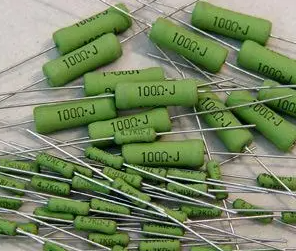1. Function of fuse resistor.
The fuse resistor plays the dual role of fuse and resistor in the circuit diagram, and is mainly used in the output circuit of the power circuit and the output circuit of the secondary power supply. They generally have low resistance (several ohms to dozens of ohms) and low power (1/8" 1W). Their function is to fuse in time when overcurrent occurs and protect other components in the circuit from damage.
When a short-circuit fault occurs in the circuit load and overcurrent occurs, the temperature of the fuse resistor will rise to 500-600°C in a short period of time. At this time, the resistor layer will peel off due to heat and fuse, which plays the role of insurance and achieves improvement. The purpose of overall machine safety.
2. How to identify the fuse resistor.
Although fuse resistors are widely used in power circuits, the marking methods in circuit diagrams vary from country to country and manufacturer. Although the labeling symbols are not yet unified, they have common characteristics:
(1) They are obviously different from the markings of general resistors, which is easy to judge in the circuit diagram.

(2) It is generally used in low-voltage or high-voltage circuits with large current capacity of power circuits or secondary power supplies.
(3) There is only one color ring on the fuse resistor. As shown in the attached figure, the color of the color circle indicates the resistance value.
(4) In the circuit, the fuse resistor has long legs welded on the circuit board (generally the resistor is welded close to the circuit board) and is far away from the circuit board, which facilitates heat dissipation and distinction.
3. Common specifications and standards for fuse resistors.
(1) RN1/4W, 10Ω fuse resistor, color ring is black, power is 1/4W; when 8.5V DC voltage is applied to both ends of the fuse resistor, the resistance increases to more than 50 times the initial value within 60 seconds.
(2) RN1/4W, 2.2Ω fuse resistor, the color ring is red, the power is 1/4W; when 3.5A current passes through, the resistance increases to more than 50 times the initial value within 2 seconds.
(3) RN1/4W, 1Ω fuse resistor, color ring is white, power is 1/4W; when 2.8A AC current passes through, the resistance increases to more than 400 times the initial value within 10 seconds.
